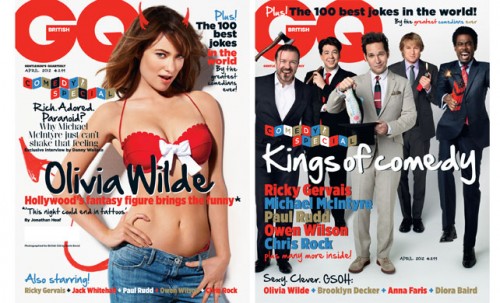 Cross-posted at Sociology in Focus.
Cross-posted at Sociology in Focus.
Back in 1987, Raewyn Connell coined the term hegemonic masculinity in a seminal text, Gender & Power. Hegemonic masculinity refers to the dominant form of masculinity that exists within a particular culture. Relative to this ever changing, idealized form of masculinity are different subordinated masculinities – those within a culture that do not live up to the so-called masculine gold standard. Put simply, there are “real men” and then there are all other men.
In watching the 2012 Super Bowl commercials, we can see versions of hegemonic masculinity demonstrated. Perhaps the most vivid version was seen in H&M’s Super Bowl ad, utilizing soccer (futbol) star, David Beckham:
[youtube]https://www.youtube.com/watch?v=fjd6i0S67HQ[/youtube]
Tattooed, rugged, athletic, showcasing a lean musculature and menacing glare, Beckham embodies a hegemonic masculinity that would surely resonate with sporting audiences. And while not presented in this commercial, it is important to also note that Beckham carries other cultural traits that ad to his hegemonic masculine status – he is globally recognized, financially wealthy, and married to a woman who also holds currency in popular culture. This last point is critical. By being married, Beckham confirms his heterosexuality, and her extraordinary beauty and international popularity raise his standing as a “real man”.
In contrast to Beckham, other males were presented in this year’s Super Bowl commercials, who represent a marginal masculinity, meaning they would love to hold hegemonic masculine status and are pursuing such an identity, but for any number of reasons are unable to achieve it. You could say these are the “wannabe real men”. A good example of marginal masculinity is presented in the following commercial for FIAT:
[youtube]https://www.youtube.com/watch?v=GxQsLdwCtMU[/youtube]
In contrast to the commercial with Beckham, the male in this commercial lacks qualities that would otherwise provide him with a sense of hegemonic masculinity. Although he appears to be employed (wearing business attire), he is relatively short in comparison to the woman in the ad, cast as nerdy and lacking confidence. Given the fantasy he has with the female actor, we can see he desires hegemonic masculine status. But because he lacks a kind of physical prowess, he is marginalized.
Of even greater importance here, the concept of hegemonic masculinity is not only about men and their relation to one another. Hegemonic masculinity also represents a cultural system that dominates women. Thus, the FIAT commercial is also useful because it illustrates women’s overall subordination. Connell also defined the term “emphasized femininity”, which refers to women’s “compliance with this subordination… oriented to accommodating the interests and desires of men” (p. 183).
When women emphasize their femininity – or are coerced to emphasize their femininity – they are often times objectified. Objectification refers to the depersonalization of someone, such that her/his humanity is stripped and the person(s) is turned into an inanimate object. Sociologists have argued that when humans are objectified, they tend to be “seen as less sensitive to pain,” and, “we care less about their suffering” (Loughnan et al., 2010, p. 716). In other words, when we turn people into object, we remove their humanity, and it is easier to commit violence against them. Feminists commonly argue the objectification of women in the media facilitates women’s ongoing victimization in society at large.
In the FIAT commercial, the woman “emphasizes her femininity” by catering to the male’s sexual desires. She is also objectified – likened to an inanimate car that would lack human feelings and emotion. Go Daddy also aired a commercial clearly objectifying women, where female celebrities paint another female, who is used as an inanimate, sexualized prop to promote the Go Daddy company.
[youtube]https://www.youtube.com/watch?v=q9ucBY_2WEA[/youtube]
While the Super Bowl is known primarily as a sporting event where millions of Americans tune in each year to watch men engage in athletic competition, the event also includes advertising content that is highly gendered. With so much attention attention directed to this advertising, it is important to dissect it through a gendered framework.
———————————–
David Mayeda is an Assistant Professor in the Department of Sociology and Legal Studies at Hawaii Pacific University. His recent book publications include Celluloid Dreams: How Film Shapes America and Fighting for Acceptance: Mixed Martial Artists and Violence in American Society. He also blogs at The Grumpy Sociologist.
Lisa Wade, PhD is an Associate Professor at Tulane University. She is the author of American Hookup, a book about college sexual culture; a textbook about gender; and a forthcoming introductory text: Terrible Magnificent Sociology. You can follow her on Twitter and Instagram.
 Symbolic interactionism, one of the most common theoretical perspectives adopted by sociologists, explains human behavior through the meanings we place on objects or symbols in our environment. These symbols can be material objects, but they can also be words, gestures, actions, events, as well as people and groups. The symbols’ meanings are not innate. They are created and applied through human relations and interactions. In other words, they are socially constructed. Consequently, our behaviors and relationships change as meanings are altered. Some social conflict is the result of different groups defining objects differently.
Symbolic interactionism, one of the most common theoretical perspectives adopted by sociologists, explains human behavior through the meanings we place on objects or symbols in our environment. These symbols can be material objects, but they can also be words, gestures, actions, events, as well as people and groups. The symbols’ meanings are not innate. They are created and applied through human relations and interactions. In other words, they are socially constructed. Consequently, our behaviors and relationships change as meanings are altered. Some social conflict is the result of different groups defining objects differently.











